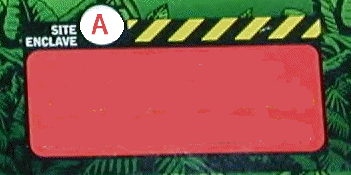
The Sky's of the Mesozoic from the Dinosaur Collector
updated 02/05/10
Pterosaurs evolved in the Triassic and declined in the Late Cretaceous. They can be divided into two groups the Rhamphorrhynchoidea and Pterodactyloidea. The tailed Rhamphorynchoids flourished until the Late Jurassic. The Pterodactyls split off from them in the Early Jurassic and become extinct at the end of the Cretaceous. Most commonly pterosaurs are considered archosaurs, cousins of the dinosaurs although some like Bob Bakker have argued they should be included in dinosauria. The opposing view more popular with Pterosaur specialists is that they are a branch of eosuchians the group that include snakes and lizards. Older theories described them as gliders who could only become air born in strong winds. Modern scholars see them as active
Put mouse on pictures to find hot spots
| Found primarily in Early Cretaceous northwestern China Dsungaripterus was a medium sized Pterodactyloid with a wing span no larger than three meters. The jaws are specialized: the upper jaw is upturned and modified to snap open clams. The front of the mouth is toothless, while the back contains broad blunt teeth, which may have helped in crushing the shells. It may have lived in colonies. | Pterodactylus was a relatively small and was covered in hair-like integument, with a mane of longer hair running down the back of its neck. The feet also showed evidence of webbing, and the remains of a small, hooked beak were preserved at the tip of the upper jaw. | |
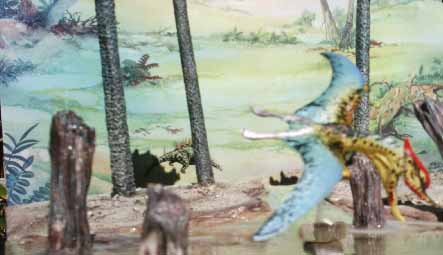
|
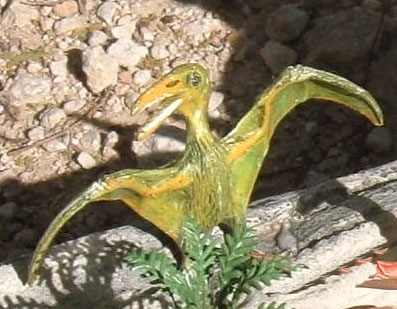 |
|
| Dsungaripterus from the UHA Collectors Club diorama courtesy of Toyosaurus. | Giga Pteranodon painting and picture by Fred Hinojosa. |
Ornithocheirus (bird hand) lived during the Early Cretaceous. It had a long, tapering, toothed snout with a bony crest. The skull was roughly 4.8 ft (1.5 m) long; the body was 11.5 ft (3.5 m) long. Ornithocheirus had a wing span of about 38 ft (12 m) and had a very short tail. At the beginning of the Cretaceous period, short-tailed pterosaurs like Ornithocheirus replaced the earlier long-tailed varieties. They also started to grow much larger. It seems to have had a world wide distibution. It was the main character in the WWD chapter "Giants of the Sky"
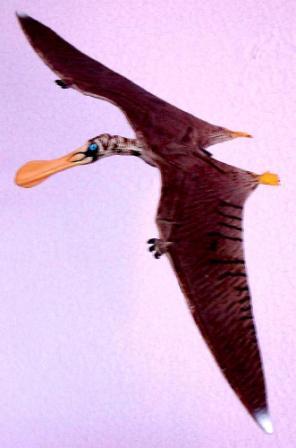
This is the very rare Ornithocheirus by Toyway premium from Planet Three Publishing. Submiited by Vlad Petnicki. This figure was supposed to be part as the second group released but it was too fragile because of the large wings.
| Pteranodon sternbergi was the largest of the pteranodon species. It was characterized by an upright crest. The crest is more spade like as opposed to the cone shaped crest seen with Pteranodon ingens. They must have lived a life like today's sea birds. | Pteranodon ingens lived along the cliffs of the great inland sea of covering the middle of North America in the Late Cretaceous. At 27ft it was one of the larger pterosaurs. At least some pterosaurs were covered with a coat of down or fur. They Pteranodon shared the shallow inland seas of the Late Cretaceous with the great seas going reptiles. They provided variety to the diet of these sea monsters. | |
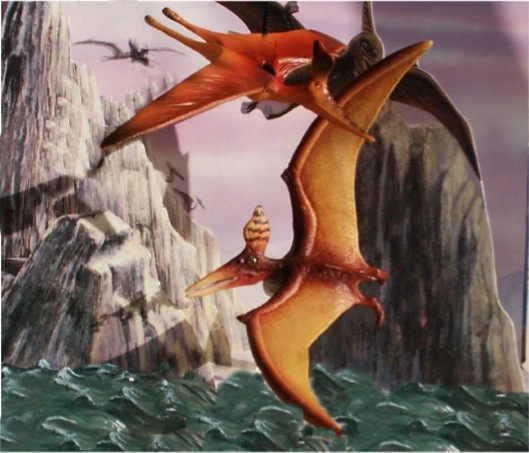
|
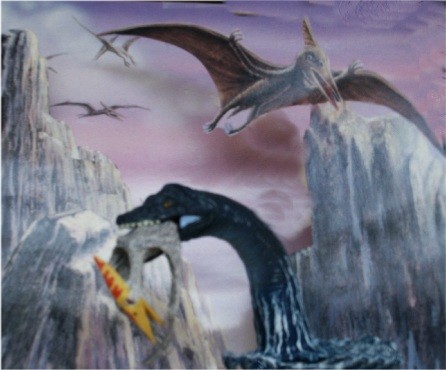
|
|
| Top is the Pteranodon sternbergi with the hanging ocean display from the Kinto My Favorite Collection donated by Healthstones hobbies. Below the Wild Safari with bendable wings. Lately there has been a surge in using the sternbergi figures with toy sets perhaps to differentiate them from the low end set s that still use igens. Wild Safari seems to being making an effort not to compete with the Carnegie Museum line. | Bandai Plesiosaurus eating Pteranodon from their diorama style figure series. Pteranodon ingens was the favorite pterosaur toy figure from the Marx days. The only Rhamphorhynchus every showed up in lesser toys lines. |
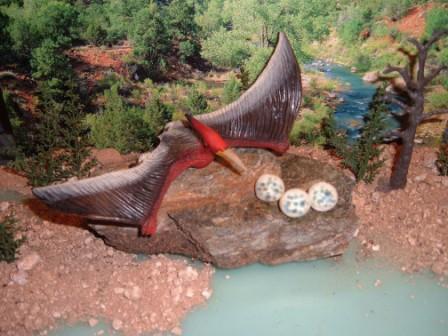
Custom Invicta Pteranodon and picture by Fred Hinojosa.
| Pterosaurs seem to have grown fast like modern birds. All this indicates they were to some degree warm blooded. |

|
| Pteranodons from Safari , Oriental Trading Company, UKRD (Boley), Jasman and from China a WaiPhoon ROM copy. |
| Pteranodon was a strong flier using its toothless beak to fish widely over the intercontinental sea. Pterosaurs gave birth to live you rather than laying eggs. The chicks climbed on to and attached themselves to the mothers presumably accompanying them in flight. The stance of the grounded Pterosaur has been debated. The weight of evidence seems to favor a 4 limbed stance on the ground rather than a two legged bird like pose as seen in the Bullyland figures |

|
| Four Various Bullyland Pteranodons and two of the Boley figures a yellow from UKRD and the large green figure. The lower front figure is a safari copy from the Dino-Might Groovy Tube Dinosaur set. |
| The common assumption is that pterosaurs are limited in Late Cretaceous to a few remaining giant forms. The limited number of sites means that a skeptical view is warranted. Perhaps the last pterosaurs were being stressed by the success of birds. Becoming specialized for large size is often the last adaptation we see before a group dies out. |
 |
| Carnegie Safari Pteranodons ingens and gray Quetzalcoatlus. The Wild Safari Pteranodon sternbergi with distinctive head crest. The perched Pteranodon ingens is from the the Safari Habitat series. |
Quetzalcoatlus (feathered serpent) lived inland from the sea perhaps it was a carrion feeder although it also be the Mesozoic version of the frigate bird or albatross living on fish. It was the last known pterosaur and survived to the end of the Cretaceous. It had a wing span of 36 to 39 feet, the size of a same plane. Trackways show it walked on four feet.
Schleich Quetzalcoatlus
Click on the Site A
icon to the right to return to home page.